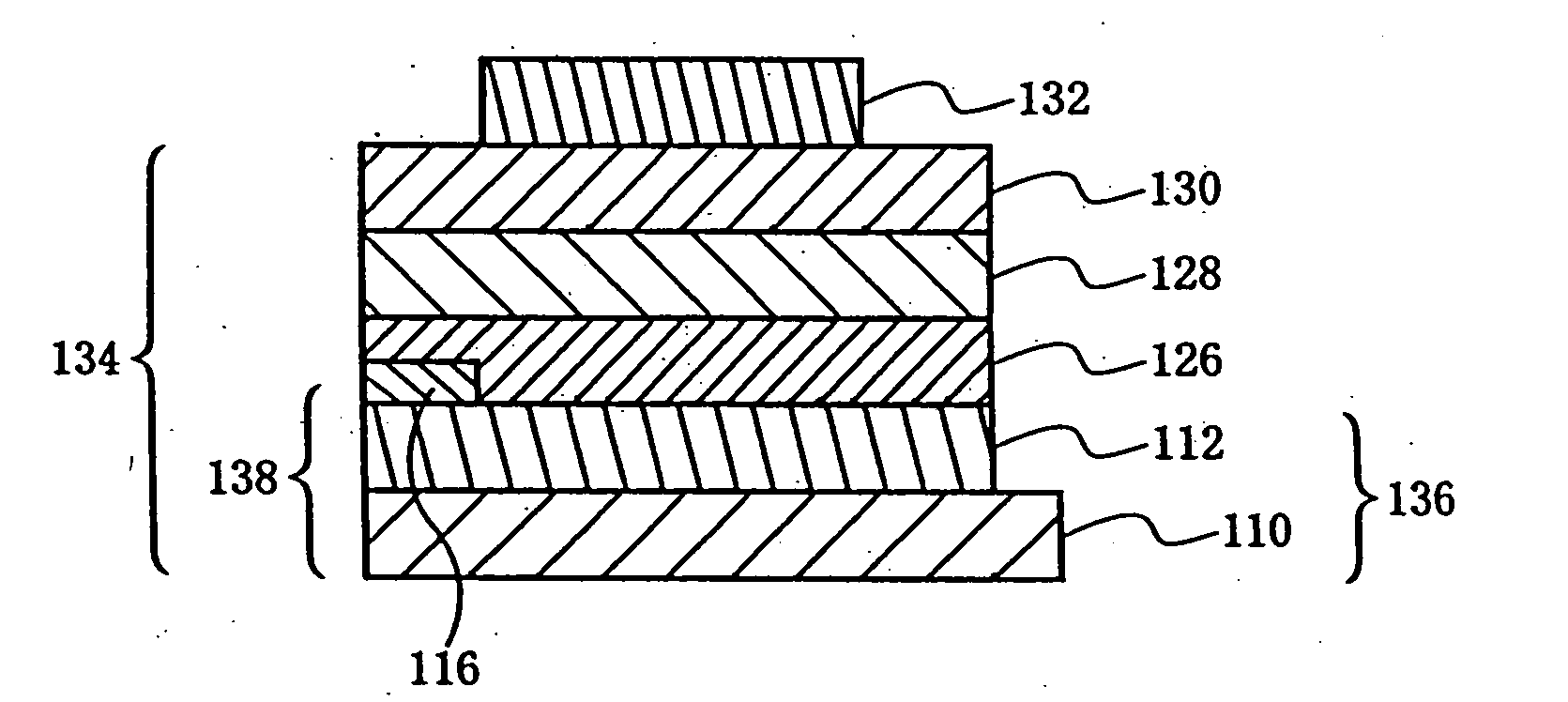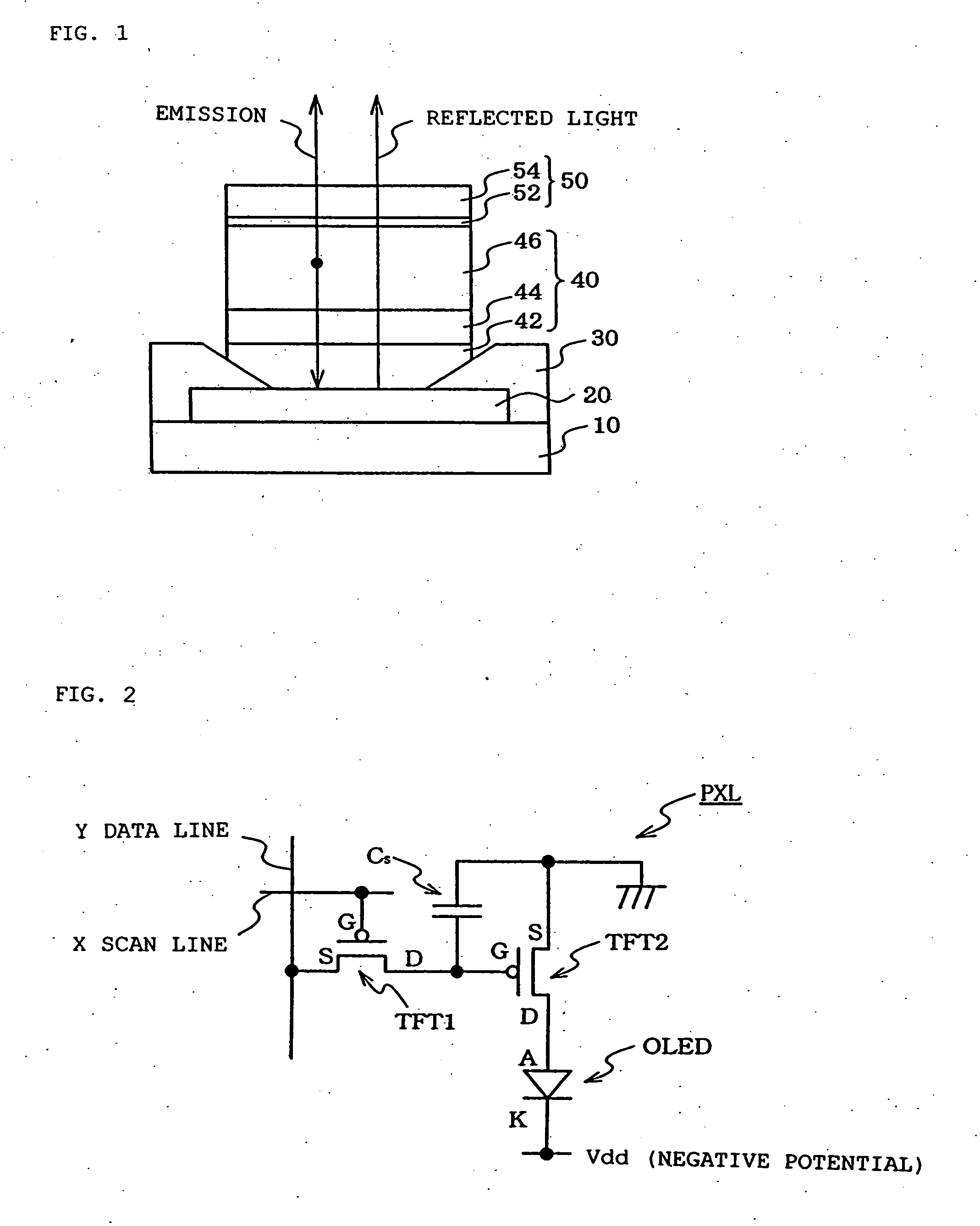Organic electroluminescence device, conductive laminate and display
a technology of electroluminescent devices and laminates, applied in the direction of organic semiconductor devices, discharge tubes luminescnet screens, conductive layers on insulating supports, etc., can solve the problems of deterioration of el devices or short circuits, work function decreases with time, and inability to secure uniform quality, etc., to achieve large work functions, reduce the drive voltage and increase the lifetime of organic el devices
- Summary
- Abstract
- Description
- Claims
- Application Information
AI Technical Summary
Benefits of technology
Problems solved by technology
Method used
Image
Examples
first embodiment
[0050]FIG. 1 is a view showing one embodiment of an organic EL device according to the invention. An anode 20, an insulating layer 30, an emitting layer 40, and a cathode 50 are formed on a substrate 10. The emitting layer 40 includes a hole injecting layer 42, a hole transporting layer 44, and a luminescent medium layer 46. The cathode 20 includes a metal layer 22 and a transparent conductive layer 24. The insulating layer 30 is not indispensable, but is preferably provided in order to prevent a short circuit between the anode 20 and the cathode 50.
[0051] In the luminescent medium layer 46, holes supplied from the anode 20 and electrons supplied from the cathode recombine to emit light. The light is outcoupled upward through the cathode 50.
[0052] According to the first embodiment, at least a part of the anode 40 in contact with the hole injecting layer 42 contains at least one element selected from lanthanum, cerium, neodymium, samarium, and europium, and at least one element sel...
second embodiment
[0057]FIGS. 2, 3, and 4 are views showing one embodiment of a display using the organic EL device according to the invention.
[0058]FIG. 2 is a view showing an equivalent circuit of one pixel of an active matrix type display.
[0059] In the active matrix type display, a number of pixels are arranged in a matrix, and an image is displayed by controlling the light intensity in pixel units corresponding to luminance information provided. In the active matrix type display, current flowing through an organic EL device provided in each pixel is controlled by an active device (generally a thin film transistor (TFT) which is one type of insulated gate type field effect transistor) provided in each pixel.
[0060] A pixel PXL includes an organic EL device OLED, a thin film transistor TFT1 as a first active device, a thin film transistor TFT2 as a second active device, and a storage capacitor Cs. Since the organic EL device generally has rectification properties, it may be called an organic ligh...
third embodiment
[0067]FIG. 5 is a view showing one embodiment of an organic EL device according to the invention.
[0068] An organic EL device 134 corresponds to an example of the organic EL device defined in the claims. The organic EL device 134 includes a transparent conductive substrate 138 including a glass substrate 110 and a transparent conductive film 112, a hole transporting layer 126, an organic emitting layer 128, an electron injecting layer 130, and a cathode layer 132.
[0069] A feature of the third embodiment is to produce the transparent conductive substrate 138 including the transparent conductive film 112 having a large work function. Another feature of the third embodiment is to produce the organic EL device 134 which shows a small increase in voltage during constant current drive and exhibits long lifetime and high luminance using the transparent conductive substrate 138 as an electrode.
[0070] Each constituent member and the production method are described below.
A. Conductive Mul...
PUM
| Property | Measurement | Unit |
|---|---|---|
| work function | aaaaa | aaaaa |
| binding energy | aaaaa | aaaaa |
| binding energy | aaaaa | aaaaa |
Abstract
Description
Claims
Application Information
 Login to View More
Login to View More - R&D
- Intellectual Property
- Life Sciences
- Materials
- Tech Scout
- Unparalleled Data Quality
- Higher Quality Content
- 60% Fewer Hallucinations
Browse by: Latest US Patents, China's latest patents, Technical Efficacy Thesaurus, Application Domain, Technology Topic, Popular Technical Reports.
© 2025 PatSnap. All rights reserved.Legal|Privacy policy|Modern Slavery Act Transparency Statement|Sitemap|About US| Contact US: help@patsnap.com



